As a manager, you know supporting your team is critical to success. But, with so many responsibilities competing for your time and attention, it can be tough to give each employee the individual guidance they need. That’s where one-on-one meetings come in – they’re your secret weapon for building strong relationships, driving performance, and unlocking your team’s full potential.
What Is a One-on-One Meeting?
![]()
These meetings are more than just status updates. They’re a chance to build trust, give guidance, and foster open communication. Think of them as a combination of a check-in, coaching session, and feedback exchange. The goal is to support and help your team members succeed while staying aligned with broader team and company objectives.
What Are the Benefits of a One-on-One Meeting?
![]()
You might be wondering, “What’s in it for me and my team?” Let’s break down the benefits:

Benefits for Your Staff
For your employees, one-on-one meetings provide a safe space to share their thoughts, concerns, and aspirations. They get your undivided attention and can discuss topics they might feel uncomfortable bringing up in a group setting. This fosters a culture of open communication, making them feel heard, respected, and valued.
Regular 1:1s also ensure your staff receives timely feedback, guidance, and recognition for their work. They can get clarity on priorities, troubleshoot challenges, and feel supported in their professional development. This consistent support boosts their confidence, motivation, and performance.
Benefits for You
As a manager, one-on-one meetings give you valuable insights into your team’s workload, progress, and well-being. You can proactively identify and address issues before they escalate, gather ideas for process or product improvements, and become a more effective leader.
1:1s also allow you to build stronger relationships with your employees by understanding their needs, work styles, and motivators. This knowledge enables you to tailor your management approach and unlock their full potential. Coaching your team to success can be one of the most rewarding aspects of leadership.
Benefits for the Company
From a company perspective, one-on-one meetings contribute to a culture of open communication, continuous feedback, and employee development. They help align individual goals with organizational objectives, leading to better performance and business outcomes.
1:1s also improve talent retention by making employees feel heard, valued, and supported. When managers take the time to invest in their staff’s success, it sends a powerful message about the company’s commitment to its people. This can enhance the employer’s brand and attract the best talent.
Tips for the Most Successful One-on-One Meeting
![]()
Now that we’ve covered the “why” of one-on-one meetings, let’s dive into the “how.” Here are some tips to make your 1:1s as productive and impactful as possible:

How Often You Should Meet
The frequency of your 1:1s will depend on factors like team size, project demands, and employee experience level. As a general rule, aim for at least bi-weekly meetings with each team member. Weekly check-ins can provide extra support for new hires or employees taking on stretch assignments.
Keep in mind that one-on-one meetings are about quality, not just quantity. It’s better to have a focused, meaningful conversation every two weeks than rushed, surface-level chats every few days. The key is to find a cadence that allows for regular touchpoints without overburdening your calendar.
How To Prepare for Your One-on-One Meeting
It’s important to come prepared to make the most of your 1:1 time. Review your notes from the previous meeting and jot down any updates, questions, or topics you want to cover. Check-in on project statuses, deadlines, and goals.
It’s also smart to remind employees a day or two before the meeting, asking them to come prepared with an agenda or talking points. This ensures a two-way dialogue and allows your employee to reflect on their progress, challenges, and priorities.
That said, not all employees will be super prepared, especially in the beginning. Be ready to guide the conversation and ask prompting questions. Over time, as 1:1s become a regular habit, your staff will likely take more ownership of the agenda.
Where You Should Meet
Whenever possible, hold your one-on-one meetings in person in a quiet, private space where you won’t be interrupted. This could be your office, a small conference room, or even a coffee shop or outdoor area (if your company allows off-site meetings).
Video calls are the next best option if you manage a remote team or have remote employees.
Avoid 1:1s over the phone, as it’s harder to read body language and nonverbal cues. Face-to-face conversations, whether in person or via video, help build rapport and trust.
1:1 Meeting Notes
Taking notes during 1:1s is crucial for tracking discussions, decisions, and action items. Use a shared document or template where you and your employee can add topics before the meeting and capture notes during the conversation.
Make sure to review and follow up on action items from previous meetings. This could include providing resources, making introductions, or giving feedback on a deliverable. Following through on your commitments builds trust and accountability.
What Do We Talk About in a One-on-One Meeting
![]()
The beauty of one-on-one meetings is that they can cover a wide range of topics, depending on your employee’s needs and goals. Here are some common focus areas:
Regular Check-In
For your recurring 1:1s, you’ll want to start with a few general questions to get the conversation going. Here are some recommendations from the Ambrion leaders:
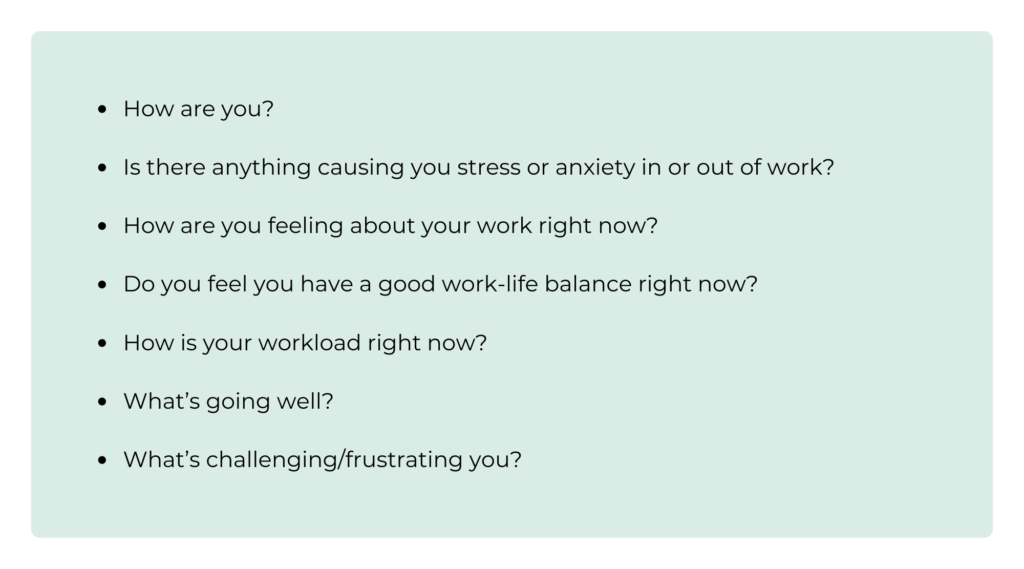
Then, you can cover workflow-related questions:
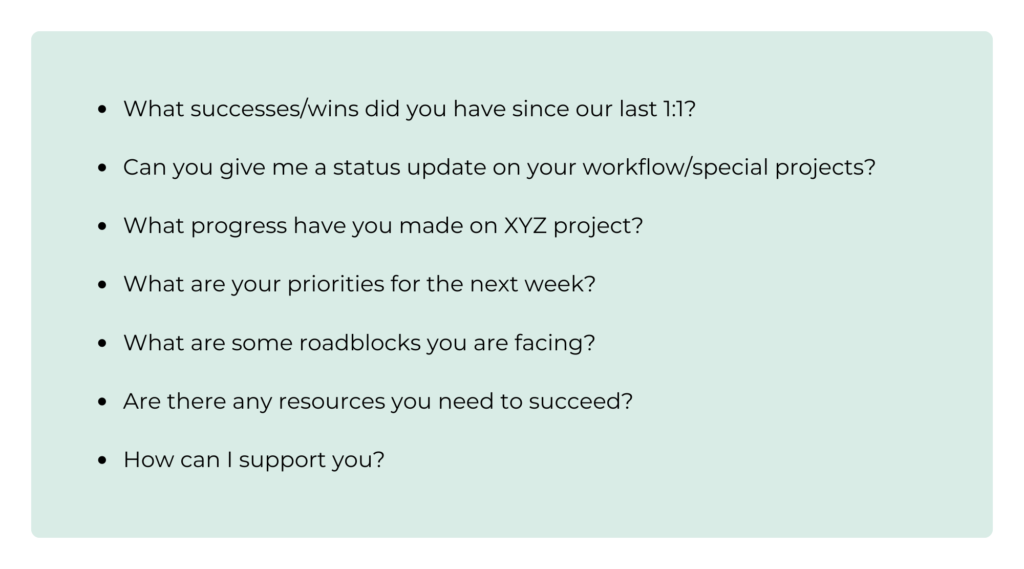
These questions help you stay connected to your employee’s work and well-being. They also create space for your team members to ask for help, share ideas, or raise concerns.
First One-on-One Meeting With Your New Hire
Your first 1:1 with a new employee is a chance to set expectations, learn about their background and goals, and start building rapport. Some key questions to ask:
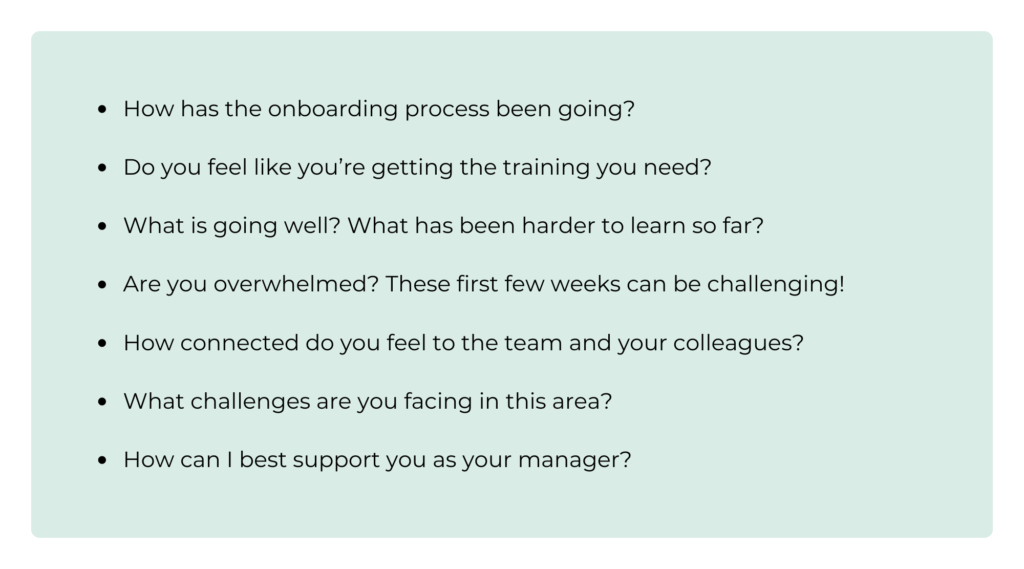
This initial conversation sets the tone for your working relationship. It’s an opportunity to demonstrate your investment in your new hire’s success and create a foundation of open communication.
Goal Setting
One-on-one meetings are a great time to plan, discuss, and align on goals. At the beginning of each year, you and your employee should establish clear goals. Then, throughout the year, we recommend that you take time once a month to discuss progress on these goals. This regular check-in allows you to:
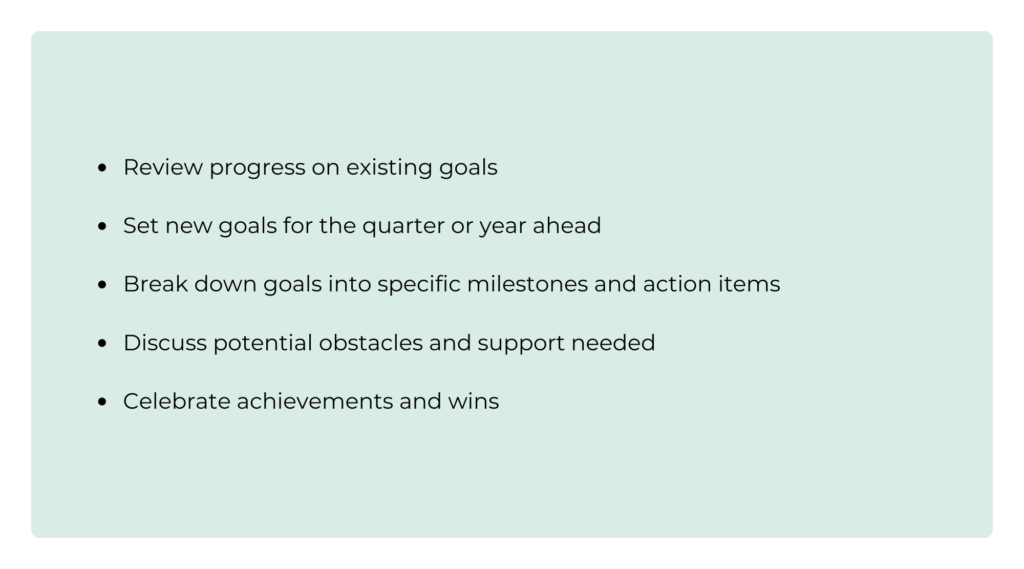
Remember to tie individual goals back to team and company objectives. This will help your employee see the bigger picture and understand how their work contributes to overall success.
Annual Career Development Conversations
Supporting your team’s professional development is a vital part of being a manager. Our Ambrion leaders recommend this be an annual check-in to:
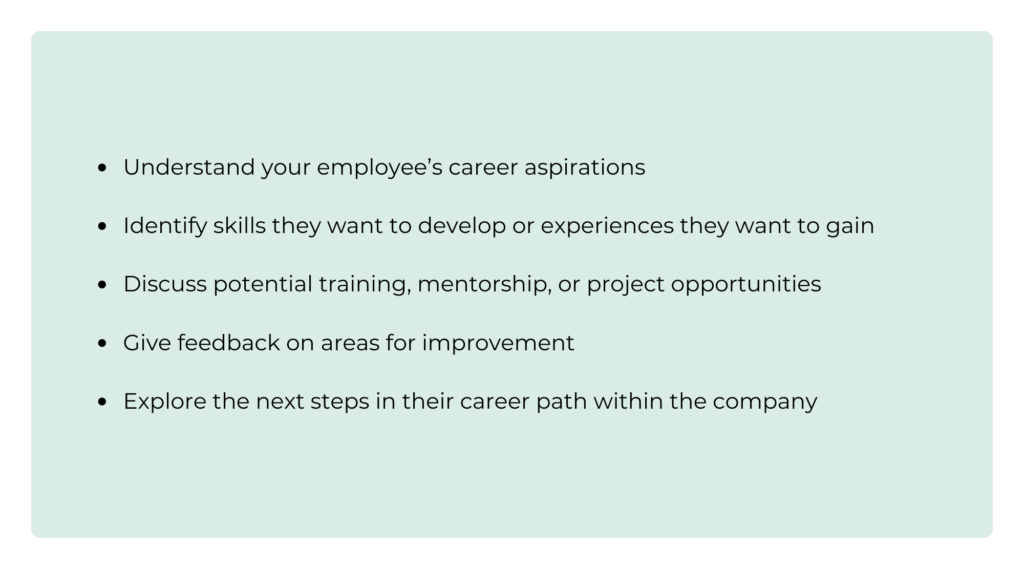
These conversations show your commitment to your employee’s long-term success and go back to the goal-setting 1:1s mentioned above. They also help you identify high-potential talent and plan for future roles and succession.
Performance Conversations
While formal performance reviews typically happen annually or semi-annually, 1:1s provide an ongoing opportunity to discuss performance. You can use this time to:

The key is to make these conversations a regular, low-pressure part of your 1:1s. This way, there will be no surprises come review time, and your employees will have a clear understanding of where they stand.
Our Ambrion leaders recommend using each 1:1 as a chance to get a real pulse on how your team members are doing. Start small – think gentle nudges rather than full-blown reviews to challenge and steer them in the right direction. This approach opens the door for honest conversations and helps you gauge how they’re really doing. By making this a regular part of your chats, you’re creating an environment where your team feels comfortable sharing their struggles and successes alike.
Handling Difficult Conversations
Sometimes, one-on-one meetings may involve addressing sensitive topics or challenging situations. When handling difficult conversations:

Remember, the goal is to have a constructive dialogue that leads to positive change, not to blame or criticize.
Example:
Sam, a finance manager, began holding weekly 1:1s with her team member, Chuck, who was struggling with time management and missing deadlines. During their meetings, Sam and Chuck discussed his workload, identified areas where he needed support, and set clear expectations for project deliverables.
Over time, Chuck’s performance improved significantly. He felt more comfortable communicating his challenges and asking for help when needed. Sam’s consistent coaching and feedback helped Chuck develop better time management skills and take ownership of his work. As a result, Chuck became a more confident and reliable member of the team.
Final Thoughts
![]()
One-on-one meetings are a powerful tool for managers to build strong, trusting relationships with their team members. Investing time in regular, meaningful conversations can support your employees’ success, drive better business outcomes, and make you a more effective leader.
As with any new habit, consistency is key. Stick to your 1:1 schedule as much as possible and communicate if you need to reschedule. Over time, you’ll start to see the cumulative benefits of these conversations—for your team, yourself, and the company as a whole.
Related Blogs You’ll Enjoy
![]()
- 5 Tips to Strengthen Workplace Culture
- The Leader’s Guide to Effective Upskilling
- 10 Steps to Onboard New Employees
Free Resource: One-on-One Meeting Template
![]()
We know how much those 1:1s matter, so we’ve created a user-friendly template to help you build stronger connections, nurture growth, and bring out the best in your team. Grab your copy now and give it a try!

